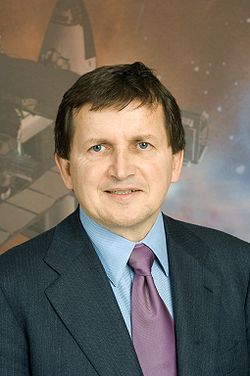Expedition 19
| Expedition 19 | |||
 | |||
| Uppdragsstatistik | |||
|---|---|---|---|
| Rymdstation: | ISS | ||
| Start: | 26 mars 2009 | ||
| Slut: | 29 maj 2009 | ||
| Tid: | 61 dagar, 23 timmar, 29 minuter | ||
| Antal besättningsmedlemmar: | 3 st | ||
| Transport | |||
| Uppskjutning: | 26 mars 2009 med Sojuz TMA-14, STS-119 | ||
| Uppskjutningsplats: | Kosmodromen i Bajkonur Kennedy Space Center | ||
| Landning: | med Sojuz TMA-14, STS-127 | ||
| Landningsplats: | Kazakstan Kennedy Space Center | ||
| Kronologi | |||
| |||
Expedition 19 var den nittonde expeditionen till den Internationella rymdstationen (ISS). Expeditionen pågick mellan den 26 mars och 29 maj 2009. Hela besättningen fortsatte i Expedition 20.
Besättningen
| Position | (26 mars - 29 maj 2009) |
|---|---|
| Befälhavare | Hans tredje rymdfärd |
| Flygingenjör 1 | Hans första rymdfärd |
| Flygingenjör 2 | Hans tredje rymdfärd |
- Gennadij Padalka (3) ISS Befälhavare -
 Uppskjutning 26 mars 2009 med Sojuz TMA-14. Fortsatte till Expedition 20
Uppskjutning 26 mars 2009 med Sojuz TMA-14. Fortsatte till Expedition 20 - Michael Barratt (1) flygingenjör -
 Uppskjutning 26 mars 2009 med Sojuz TMA-14. Fortsatte till Expedition 20
Uppskjutning 26 mars 2009 med Sojuz TMA-14. Fortsatte till Expedition 20 - Koichi Wakata (3) flygingenjör -
 Uppskjutning 15 mars 2009 med Discovery STS-119 för att ingå i Expedition 18. Fortsatte till Expedition 20.
Uppskjutning 15 mars 2009 med Discovery STS-119 för att ingå i Expedition 18. Fortsatte till Expedition 20.
(#) antal rymdfärder som varje besättningsmedlem avklarat, inklusive detta uppdrag.
Rymdturist
Rymdturisten Charles Simonyi gjorde sitt andra besök på ISS när han gästade expedition 19 i tolv dagar. Han medföljde Sojuz TMA-14 och landade tillsammans med Expedition 18 med Sojuz TMA-13.
| |||||||||||||||||||||
Media som används på denna webbplats
The Expedition 20 patch symbolizes a new era in space exploration with the first six-person crew living and working onboard ISS and represents the significance of the ISS to the exploration goals of NASA and its international partners. The six gold stars signify the men and women of the crew. The astronaut symbol extends from the base of the patch to the star at the top to represent the international team, both on the ground and on orbit, that are working together to further our knowledge of living and working in space. The space station in the foreground represents where we are now and the important role it is playing towards meeting our exploration goals. The knowledge and expertise developed from these advancements will enable us to once again leave low earth orbit for the new challenges of establishing a permanent presence on the moon and then on to Mars. The blue, gray and red arcs represent our exploration goals as symbols of Earth, the moon and Mars.
Charles Simonyi will fly as space flight participant on the Expedition 15 mission next year. He posed for photos, along with his crewmates, during a press briefing at the Johnson Space Center on Dec. 13, 2006.
Expedition 19 marks the final planned period of three person occupancy, prior to increasing the crew size to 6, and occurs in the final stages of International Space Station assembly. The patch emphasizes the earth, one of the major focuses of attention and study from the orbital research outpost. The design is stylized to highlight the beauty of the home planet and the station orbiting it, next to the sun now the unquestioned 'brightest star in the sky' as viewed from earth.
Equipage de l'expédition 19 vers l'ISS.
ISS019-S-002 --- Cosmonaut Gennady Padalka (center), Expedition 19 commander; NASA astronaut Michael Barratt (left) and Japan Aerospace Exploration Agency (JAXA) astronaut Koichi Wakata, both flight engineers, take a break from training at NASA's Johnson Space Center to pose for a crew portrait. Padalka and Barratt are scheduled to launch to the International Space Station in the Soyuz TMA-14 spacecraft from the Baikonur Cosmodrome in Kazakhstan in March 2009. Wakata will fly to the station on STS-119 and will serve as a flight engineer for Expeditions 18 and 19.ISS Expedition 18 patch
This emblem represents the eighteenth expedition to the International Space Station (ISS). Featured prominently is the Roman numeral XVIII. The "X" evokes exploration, which is at the core of the indivisible cooperation of the International Space Station partners. "V" is for victory and for the five space agencies in the ISS program. "III" stands for the hope that this crew will help evolve the ISS from supporting the last three-person crew to crews of six explorers and researchers. The moon, sun and stars symbolize the efforts of the entire ISS team, which will lead to the human exploration of the moon, our solar system and beyond.











